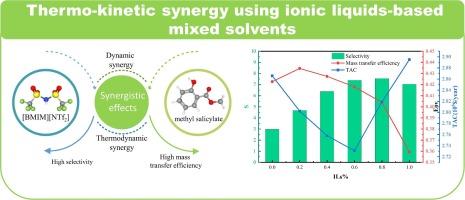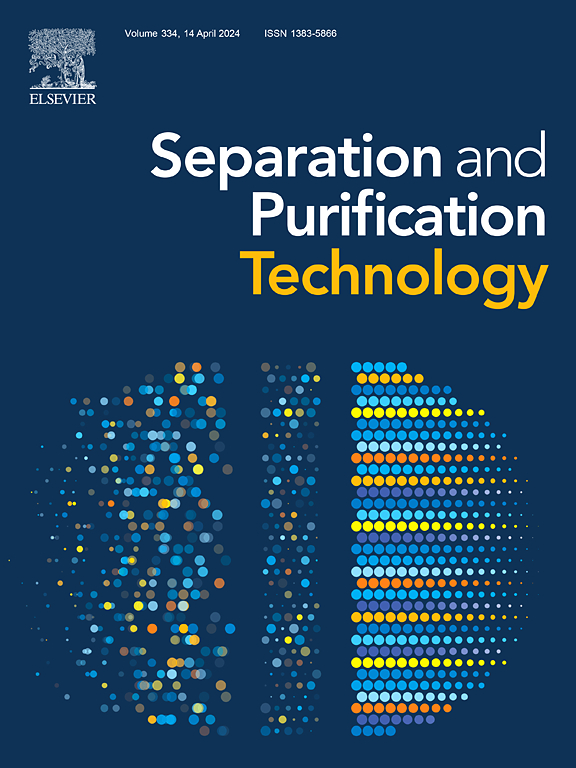使用离子液体混合溶剂分离碳酸二甲酯/甲醇/水混合物的热动力协同作用
IF 8.1
1区 工程技术
Q1 ENGINEERING, CHEMICAL
引用次数: 0
摘要
传统有机溶剂的低选择性和离子液体(IL)的高粘度导致的有限传质效率给碳酸二甲酯(DMC)/甲醇/水混合物的分离带来了挑战。因此,我们提出了一种新型混合溶剂,即水杨酸甲酯与 1-丁基-3-甲基咪唑鎓双(三氟甲基磺酰基)亚胺的质量比为 6:4。研究了混合溶剂在热力学、动力学和经济性能方面的协同效应。比较了使用直接萃取和间接萃取蒸馏顺序生产工业级和电池级 DMC 产品的四种工艺配置的总体效率和年度总成本(TAC)。结果表明,直接萃取蒸馏法优于间接萃取蒸馏法,在生产工业级二氯甲烷时,总成本降低了 6.1%-14.3%,在生产电池级二氯甲烷时,总成本降低了 6.6%-15.8%。此外,在直接萃取蒸馏中使用混合溶剂比使用纯溶剂更有效,工业级二氯甲烷的传质系数提高了 2.8-20.9%,电池级二氯甲烷的传质系数提高了 1.8-17.8%。工业级二氯甲烷和电池级二氯甲烷的传质系数分别降低了 3.2% 至 3.6%和 4.7%至 5.7%。本文章由计算机程序翻译,如有差异,请以英文原文为准。

Thermo-kinetic synergy in separating dimethyl carbonate/methanol/water mixtures using ionic liquids-based mixed solvents
The low selectivity of traditional organic solvents and the limited mass transfer efficiency caused by the high viscosity of ionic liquids (ILs) pose challenges in separating of dimethyl carbonate (DMC)/methanol/water mixtures. Therefore, a novel mixed solvent is proposed with a mass ratio of methyl salicylate to 1-butyl-3-methylimidazolium bis(trifluoromethylsulfonyl)imide of 6:4. The synergistic effects of thermodynamic, kinetic, and economic performance using the mixed solvent are investigated. Comparisons of overall efficiency and total annual cost (TAC) for four process configurations using direct and indirect extractive distillation sequences to produce industrial and battery-grade DMC products are conducted. The results indicate that direct extractive distillation outperforms the indirect sequence, reducing TAC by 6.1–14.3 % for producing industrial-grade DMC and 6.6–15.8 % for battery-grade DMC. Additionally, using mixed solvents in direct extractive distillation is more effective than using pure solvents, enhancing mass transfer coefficients by 2.8–20.9 % for industrial-grade DMC and 1.8–17.8 % for battery-grade DMC. This approach also reduces TAC by 3.2–3.6 % for industrial-grade DMC and 4.7–5.7 % for battery-grade DMC.
求助全文
通过发布文献求助,成功后即可免费获取论文全文。
去求助
来源期刊

Separation and Purification Technology
工程技术-工程:化工
CiteScore
14.00
自引率
12.80%
发文量
2347
审稿时长
43 days
期刊介绍:
Separation and Purification Technology is a premier journal committed to sharing innovative methods for separation and purification in chemical and environmental engineering, encompassing both homogeneous solutions and heterogeneous mixtures. Our scope includes the separation and/or purification of liquids, vapors, and gases, as well as carbon capture and separation techniques. However, it's important to note that methods solely intended for analytical purposes are not within the scope of the journal. Additionally, disciplines such as soil science, polymer science, and metallurgy fall outside the purview of Separation and Purification Technology. Join us in advancing the field of separation and purification methods for sustainable solutions in chemical and environmental engineering.
 求助内容:
求助内容: 应助结果提醒方式:
应助结果提醒方式:


